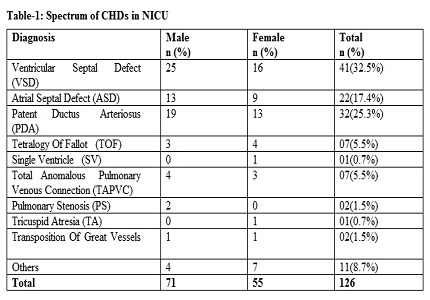Incidence of Congenital heart disease among the neonates in neonatal intensive care unit of a tertiary care hospital
Abstract
Background: A large number of newborns are affected by congenital heart diseases, which accounts for a high proportion of infant mortality worldwide. But there are regional variations in the prevalence and distribution pattern of congenital heart diseases. We evaluated the incidence, risk factors and diagnostic clues for congenital heart disease in newborns in our neonatal intensive care unit.
Methods: A prospective observational study was conducted in the neonatal intensive care unit of Vydehi institute of medical sciences between January 2013 to December 2016. Congenital heart disease was suspected if clinical and confirmed by 2D echocardiography and doppler and colour flow imaging. Data was collected on a predesigned proforma containing information regarding gender, gestational age and weight at birth, family history, and associated malformations.
Results: Out of 1974 babies screened for CHDs, 126 babies had CHDs (4.6%) of which 71(56%) were males. Most of neonates presented with Respiratory distress (52.3%), murmurs (49.5%), abnormal chest X ray (27.7%), followed by cyanosis (18.2%) in Cyanotic CHDs(100% of the cases).
Conclusion: The incidence of CHD in newborns at the neonatal intensive care unit was higher than that in all live births.VSD was the most common congenital heart defect detected while Tetralogy of Fallot was commonest among the cyanotic heart defects.
Downloads
References
2. Reich JD, Miller S, Brogdon B, Casatelli J, Gompf TC, Huhta JC, Sullivan K. The use of pulse oximetry to detect congenital heart disease. J Pediatr. 2003 Mar;142(3):268-72.
3. Hoffman JI. Congenital heart disease: incidence and inheritance. Pediatr Clin North Am. 1990 Feb;37(1):25-43. [PubMed]
4. Gupta A, Abqari S, Shahab T, Rabbani MU, Ali SM, Firdaus U. Profile and Clinical Spectrum of Congenital Heart Defects in NICU. Int Arch BioMed Clin Res. 2016 April;2(2):25-27.
5. Saxena A. Congenital heart disease in India: a status report. Indian J Pediatr. 2005 Jul;72(7):595-8. [PubMed]
6. Wren C, Richmond S, Donaldson L. Presentation of congenital heart disease in infancy: implications for routine examination. Arch Dis Child Fetal Neonatal Ed.1999; 80:49-53.
7. Bakr AF, Habib HS. Combining pulse oximetry and clinical examination in screening for congenital heart disease. Pediatr Cardiol. 2005 Nov-Dec;26(6):832-5. [PubMed]
8. Islam MN, Hossain MA, Khaleque MA, Das MK, Khan MRH, Bari MS, Bhuiyan MKJ. Prevalence of Congenital Heart Disease in Neonate in a Tertiary Level Hospital. Nepal Journal of Medical sciences 2013;2(2):91-5.
9. Hussain S, Sabir MU, Afzal M, Asghar I. Incidence of congenital heart disease among neonates in a neonatal unit of a tertiary carehospital. J Pak Med Assoc 2014; 64: 175-178.
10. Ufuk Kursat Korkmaz, Esra Akyuz Ozkan, Ayse Neslin Akkoca, Ebru Sivaslioglu. Incidence and Clinical Characteristics of Congenital Heart Disease among Neonates in Neonatal Intensive Care Unit. American Journal of Health Research. Vol. 3, No. 3, 2015, pp. 161-165.
11. Shima Y, Takechi N, Ogawa S, Fukazawa R, Fukumi D, Uchikoba Y, et al. Clinical characteristics of congenital heart disease diagnosed during neonatal period. J Nihon Med Sch 2001; 68: 510-515.
12. Khalil A, Aggarwal R, Thirupuram S, Arora R. Incidence of congenital heart disease among hospital live births in India. Indian Pediatr. 1994 May;31(5):519-2. [PubMed]

Copyright (c) 2017 Author (s). Published by Siddharth Health Research and Social Welfare Society

This work is licensed under a Creative Commons Attribution 4.0 International License.


 OAI - Open Archives Initiative
OAI - Open Archives Initiative


